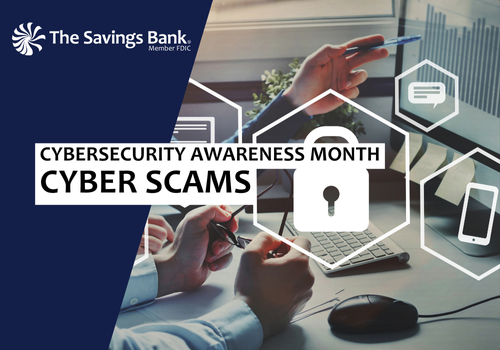Cyber Scams
10/09/2024

Cyber Scams
One unique subset of scams are cyber scams. These scams affect consumers daily and can put their personal and financial information in the hands of criminals. Cyber scams refer to any scam that originates online or via a device. Thanks to the world wide web, scammers have access to consumers oceans away, and they often use this to their advantage. Here are some of the scams and how to increase your cybersecurity to avoid them.
- Phishing, Smishing, Vishing
These types of scams are so widespread and pervasive that they can be difficult to define. At their core, they are fraudulent contact meant to expose the victim’s personal and financial information for exploitation. This scam may come in the form of a scammer impersonating a well-known entity via email or text. The scammer may send a link for the victim to click on or a phone number for them to call. Once contact has been made, many scammers will either try to obtain sensitive information like social security numbers, online banking credentials, or access to a device.
How to Avoid
- Never share multi-factor authentication codes
- Maintain separate passwords for each online account
- Never click links in emails, texts, or online messages
- Always verify phone numbers
- Spoofing
Many scammers are also using spoofing tactics to fool consumers into believing they are someone they are not. Some will do so by creating fake websites to impersonate a business or entity. Others will send emails from a fake email address to impersonate people, and still others will use AI to impersonate the voice or name of someone else on a phone call. Because of the nature of these scams, they can be incredibly hard to spot. Consumers can lose money and their personal information if they are not careful.
How to Avoid
- Only contact entities at verified phone numbers, email addresses, and websites
- Verify any new or unsolicited communications
- Malware
Malware refers to software like worms, trojan horses, or viruses which infect your device in order steal information and hold your device hostage. Most of the time, these scams manifest through social media and click-bait articles. Scammers will often create posts linking to an article with an eye-catching title. Once the victim clicks on it, the malware is introduced to the device. From there, the criminals will try to gain information or further access to the device. Even more nefarious, they may impersonate an IT expert who can “fix” the issue to further scam the victim.
How to Avoid:
- Never click on links from unverified sources, especially on social media
- Install security software on devices
Many criminals use these three scams to target consumer’s online banking. If they can use phishing or spoofing to get consumers to divulge their online banking credentials, they will have unfettered access to their victim’s funds. Because of this, it is very important for consumers to guard their online banking information. Never give anyone your username or password. There is no legitimate reason anyone could ever need access to your account. Furthermore, multifactor authentication is designed to provide an extra layer of protection for access to your accounts. Multifactor authentication codes should only ever be used by you.
If you believe you or someone you know may be the victim of a cyber scams, immediately change all passwords, lock down your accounts, and contact the appropriate entities.
Sources:

